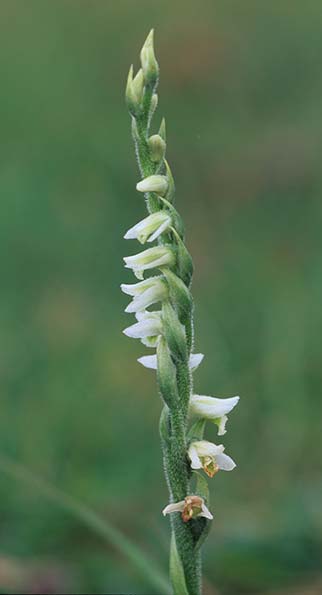Autumn lady’s tresses (Spiranthes spiralis)
When: August - September
How many: Locally abundant

Look out on short-cropped New Forest turf for autumn lady’s tresses. A member of the orchid family, autumn lady’s tresses are reasonably widespread in the New Forest, though never particularly conspicuous. Once accurately described as curious little plants, autumn lady’s tresses' white flowers splashed with pale greenish-yellow are arranged spirally in a single row up the stem.
Autumn lady’s tresses: the name is a bit of a misnomer, for the flowering season starts in August and goes through to September, and is largely over by the time autumn properly arrives. Autumn lady’s tresses do, though, flower a little later than the closely related but now no longer found summer lady’s tresses that once brightened New Forest mires in July and August.
The lady’s tresses element of the name is, however, accurate, and comes from the similarity of the spirally twisted flowers to a braid of hair.
Autumn lady’s tresses favour areas of old, dry grasslands, and need a short sward in which to grow, so heavily grazed New Forest lawns suit them well. Numbers are often high and colonies dense, but a height of no more than 20 centimetres (8 inches) and pale coloration often makes autumn lady’s tresses quite difficult to find.
The single, upright flowering stem appears from the side of a flattened, rose-like group of pointed, bluish-green leaves. The leaves of autumn lady’s tresses wither before flowering time, when the blooms’ delicate fragrance attracts pollinating, night-flying insects.
These attractive plants can sometimes be seen in abundance, but do not always appear annually. Autumn lady’s tresses seem to like hot weather with rain just before the flowering season, although it has also been suggested that numbers are influenced by the varying activity of a soil-based fungus that forms with the plant a mutually beneficial relationship - the fungus provides the plant with phosphates, whilst in return, the plant supplies the fungus with sugar.
John Wise, writing of the New Forest in the mid-19th century, refers to Spiranthes autumnalis, or late-flowering lady’s tresses, as the plant was then known, which he says were ‘very common in the pastures near the New Forest, and on the turfy spots of the New Forest lanes on the southern part.’
The herbalist William Turner in 1548 noted of autumn lady’s tresses that ‘it bryngeth forth whyte floures in the ende of harveste, and it is called Lady traces’.
John Gerard in The Herball or General Historie of Plantes, first published in 1597, called autumn lady’s tresses Sweet Cullions – cullions referred to the plant’s underground, testicle-like tubers, whilst sweet was clearly a reference to the fragrance.
Gerard advised that ‘the full and sappy rootes of Ladie traces eaten or boiled in milke and drunke, provoke venery, nourish and strengthen the bodie, and be good for such as are fallen into a consumption or fever….’
And as with a number of orchid species, the shape of autumn lady’s tresses' tubers encouraged use as an aphrodisiac!
References:
Wild Orchids of Hampshire and the Isle of Wight: Martin N. Jenkinson
The Flora of Hampshire: Anne Brewis, Paul Bowman and Francis Rose
The Wild Flowers of Britain and Northern Europe: Richard Fitter, Alastair Fitter and Marjorie Blamey
Collins New Generation Guide - Wild Flowers of Britain and Northern Europe: Alastair Fitter
Reader’s Digest Field Guide to the Wild Flowers of Britain
The Encyclopedia of British Wild Flowers: John Akeroyd
The Englishman’s Flora: Geoffrey Grigson
Culpeper’s Complete Herbal: Nicholas Culpeper
The Herball or General Historie of Plantes: John Gerard
More links
Other related links
Search this site

Sadly, 58 animals were killed - 35 ponies, 13 cows, 8 donkeys and 2 sheep, whilst a further 32 were injured - 3 pigs, 9 donkeys, 11 cows and 9 ponies.
(Forty-three accidents occurred in daylight, 15 at twilight and 101 in the dark. Twenty-seven accidents were not reported by the driver involved).
Here's just one horrific example - Three donkeys killed in collision with van at notorious New Forest blackspot (Advertiser and Times)

